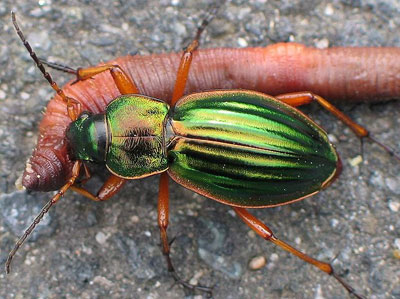Beetles … nature's workaholics

Golden ground beetle eating an earthworm. Wikipedia.org
Although many of us may prefer to keep our distance from beetles, a close look at these tireless toilers is a rewarding exercise.
Coming in all shapes and sizes, beetles are part of the largest order of insects.1 The order Coleoptera comprises beetles and weevils, and with 250,000 known species, it represents 40 per cent of all known insect species.
Despite the fact that evolutionists have fossils of ‘ancient’ beetles, they have been unable to explain how the insects developed such a wide range of characteristics.
Many beetle species vary dramatically from each other, from size and diet, to preferred habitat and survival techniques.
More beetles are found in the tropics than anywhere else. However, they can live in almost any habitat occupied by other insects, except Antarctica and the highest altitudes.
Beetles range in size from less than one millimetre to more than 12 centimetres (the length of a ball point pen!). Goliath and Hercules beetles can be up to 15 centimetres long.
Some feed on plants, while others are scavengers, predators or parasites, and some species feed on fungi.
Spider beetles feed on dead insects and animal skins, cigarette beetles on tobacco and other dried plant products, whirligig beetles on water insects, and some click beetles feed on the larvae of wood-boring insects. Soldier beetles eat worms, fireflies mainly eat snails, and some scarab beetles feed on dung. June beetles feed on grasses and leaves, and bess beetles feed on rotting logs.

Left: A spotted cucumber beetle feeds on a thistle (photo: Tom Wagner), middle: Christmas beetle, right: lady beetle (photo: Tmoertel: wikipedia.org).
Beetles can be found living below the ground, in water, and in nests of ants and termites. Beetle legs have various designs, depending on whether they swim, run, jump, clasp or dig.
Perhaps most amazing is the variety of protection techniques used by members of the Coleoptera order, including camouflage, bad smell and intimidating features.
One African beetle, Petrognatha gigas, looks like dead velvety moss, and its antennae resemble dried plant tendrils or twigs.
Some weevils fold their limbs, and look like seeds or tiny clumps of soil, and bombardier beetles fire hot smelly gases at predators.
Evolutionists regard beetles as very ancient, yet even the most ‘ancient’ specimens display the characteristics recognized in beetles today.
Encyclopaedia Britannica says ‘complete fossil specimens are closely related to living forms’, which raises the question of what ancestry evolutionists propose for beetles.
The same encyclopaedia supposes ‘they probably evolved from ancestors of the present-day Neuroptera [lacewings]’, which in turn ‘may have evolved from an early mecopteran (Scorpionfly) ancestral stem’ (emphasis added).
Evolutionists are unable to prove these theories because of the absence of evidence indicating that beetles evolved from non-beetles, despite the multitude of living and fossil beetles.
We have no reason to doubt Genesis when it says all living creatures (including creeping things) were created perfect by God.
Reference
- Encyclopaedia Britannica, 1992, Vol. 21, pp. 699, 714–722; How Insects Live, William Blaney, Gallery Press, Leicester, UK, 1977. Return to text.






Readers’ comments
Comments are automatically closed 14 days after publication.